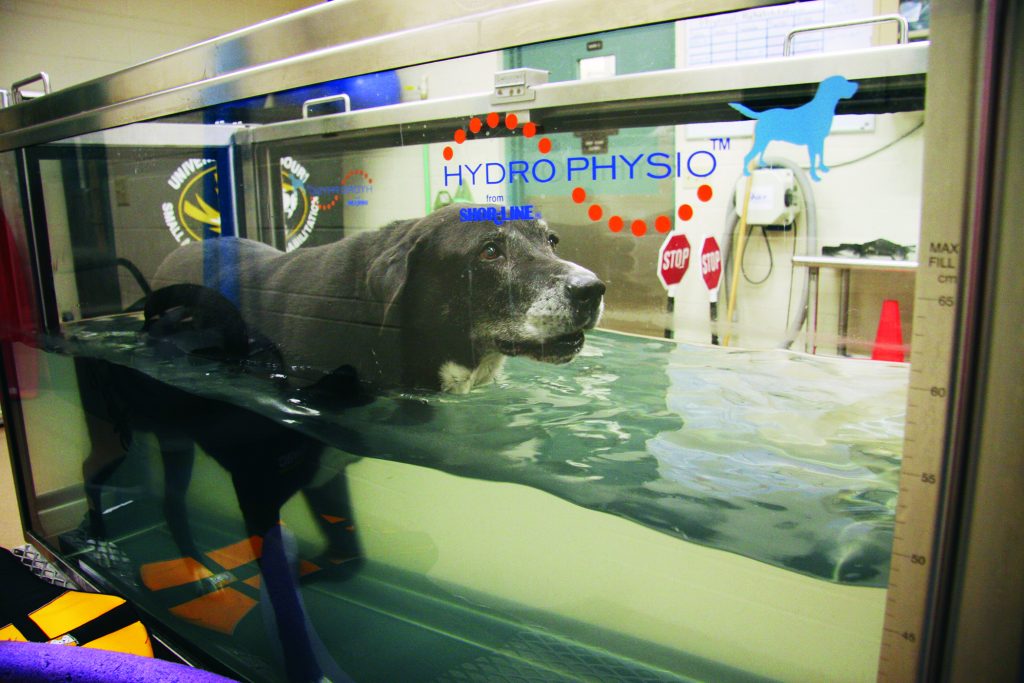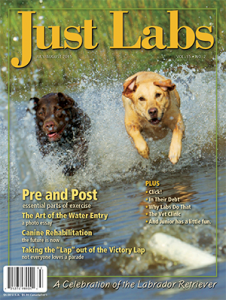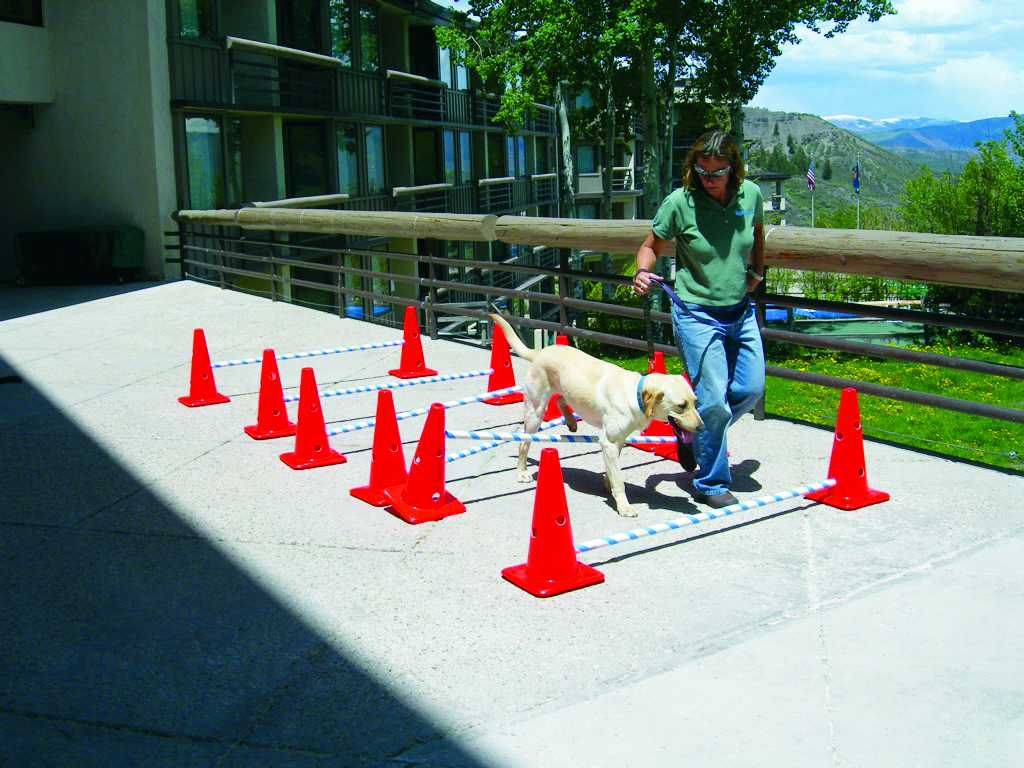by Cathy Swormstedt
You may be familiar with treatments such as hydrotherapy or muscle-building exercises, possibly because a family member needed physical therapy due to an orthopedic condition. Was that family member your dog? A growing number of people are answering, “Yes!”
The clinical practice of canine rehabilitation is a relatively new field in the U.S., but veterinarians all across the country are embracing this specialty, having seen for themselves the positive results. Whether the canine patient has had surgery, suffers from hip or elbow dysplasia, or simply needs to shed extra pounds, rehabilitation could be the answer for reducing pain, increasing joint mobility and muscle tone, and enhancing quality of life.
PT Planned and Personalized
Generally, the first step in developing an effective rehabilitation program for a particular animal involves a conference between the diagnosing veterinarian and a certified canine rehabilitation practitioner (CCRP) or therapist (CCRT) regarding the cause and severity of the issue to be addressed. Rehabilitation for orthopedic problems might include techniques such as thermotherapy, cryotherapy, hydrotherapy, muscle-building, and/or coordination exercises. Treatments for surgical repairs or traumatic injuries might warrant heat therapy, cryotherapy, massage, hydrotherapy, or electrical stimulation. Here’s an overview of often recommended procedures:
Canine Massage: Used to relieve muscle tension and stimulate muscle development.
Thermo and Cryotherapy: Application of heat packs to increase range of motion, joint stiffness, and blood flow.
Passive Range of Motion: Flexion and extension of joints to encourage animals to use their full range of motion; helpful in reducing joint pain.
Coordination Exercises: Dogs walk over obstacles and perform exercises such as figure eights to help them build strength and coordination; often used for animals recovering from spinal cord injuries or who have neurological issues.
Balance Exercises: To help strengthen weak muscles and atrophied limbs, dogs learn to balance on wobble boards, balance boards, or physioballs; helpful for dogs recovering from a stroke or dealing with a neurological condition.
Strengthening Exercises: In uphill and downhill walking, including stairs and ramps, animals learn to put weight on affected limbs, stretch hip joints, and increase range of motion; excellent for dogs with hip dysplasia or degenerative joint disease.
Hydrotherapy: Water exercise including swimming and underwater treadmill work to provide the benefits of land exercise while reducing the stress placed on limbs; often recommended for dogs recovering from surgery.
Electrical Stimulation: Used along with the techniques mentioned above either to combat pain or to stimulate muscles.

Photo Courtesy of Karen Cifford/College of Veterinary Medicine, University of Missouri.
Helping Labrador Retrievers
Large dogs, such as Labrador retrievers, are subject to canine hip dysplasia (CHD), a condition that is well-suited to treatment through canine rehabilitation techniques. In the simplest terms, CHD occurs when the ball of bone at the end of the femur becomes loose inside the joint. The joint then begins to move around, resulting in lack of proper hip support. Pain soon follows because of joint damage and inflammation. CHD can be inherited, but it can also be caused by an injury at a young age, such as a ligament tear or by an overweight condition. Symptoms – stiffness, slow movement, a reluctance to exercise – might not show up for some time, especially if the condition begins when the dog is still a puppy.
Georgia Müller-Torchik, who received her certification for canine acupressure-massage in Colombia, tends patients at the Animal Clinic and Wellness Center in Williamsburg, Virginia. “The technique is like acupuncture,” she explains, “but instead of using needles at certain pressure points, we use massage.”
Hydrotherapy is another procedure she employs with canine patients to great benefit. “I get right into the tank with them,” she says with a smile. The tank consists of a treadmill inside a large, glass-paneled, box-like structure that fills with warm water. There are ramps at both ends so that once inside, the patient doesn’t have to turn around in order to exit the tank.
Introducing a dog to water exercise sometimes takes a bit of patience. “If the dog is skittish, I just talk soothingly to him or encourage him with treats,” Georgia says, explaining that after their first experience with the water treadmill, the dogs are fine, even enthusiastic. “Labs are especially good with hydrotherapy,” she adds. “They love water, which is a big plus, and they have such a good temperament. They benefit from hydrotherapy after hip or knee surgery, especially.”
Expanding Education Options
At the University of Tennessee, groundbreaking continuing education is offered through the Certificate Program in Canine Physical Rehabilitation with instructors who are veterinarians and physical therapists. The emphasis is on “evidence-based medicine” in a comprehensive curriculum that includes access to the latest clinical and lab research plus practice and training modules that offer a wide range of treatments. The CE course is open to veterinarians and their technicians, physical therapists and PT assistants, and occupational therapists. Those who complete the program and pass the final exam receive the CCRP designation.
Darryl Millis, MS, DVM, is Professor of Orthopedic Surgery, Director of Surgical Service, in the university’s Department of Small Animal Clinical Sciences. As early as 1994, he and a colleague, physical therapist David Levine, began researching information about veterinary rehabilitation. Over time they realized that if the field were to develop in a credible manner with science and evidence at the forefront, a continuing education program would be required – thus, the Certified Canine Rehabilitation Practitioner Program was born.
“Worldwide, we have over a thousand CCRPs, and several thousand have taken the courses,” Dr. Millis explains. “Currently, approximately two hundred and fifty veterinarians, veterinary technicians, physical therapists, and physical therapist assistants take the courses each year in the U.S., Europe, South Africa, and Japan.”
Ongoing Research Beneficial to Labs
In addition to his regular practice and teaching schedule, Dr. Millis pursues his interest in research about bone healing, osteoarthritis, and postoperative physical therapy of canine orthopedic patients.
“Labs,” he says, “like other large breeds of dogs, have a variety of conditions that can be helped with physical rehabilitation, including obesity and overweight issues, osteoarthritis, hip dysplasia, elbow dysplasia, and cranial cruciate ligament rupture. We also see a number of geriatric patients that come in for strengthening and conditioning to help improve their mobility and function at home. Increasingly, we are seeing a number of sporting injuries, such as shoulder muscle and groin muscle injuries.”
Dr. Millis has written articles about stair and ramp exercise for canine patients. “Dogs use very little of the available range of motion of their joints by simply walking or jogging,” he explains. “We like to see them use their joints through a greater range of motion for mobility and strengthening, and engage in a variety of therapeutic exercises that target certain joints. Climbing stairs may indeed increase hip extension and strengthen gluteal muscles in dogs recovering from injury or surgery, or just for general strengthening and conditioning.”
This approach may not work for dogs with certain issues, however. “A dog with hip dysplasia may be reluctant to climb stairs because extension of the hip may be painful,” Millis points out. “Walking up an inclined ramp may be less painful because dogs do not need to extend their hip joints as much and can adjust their stride length to their comfort level, yet they still strengthen their gluteal muscles as they walk up the incline.”
Human and Canine Rehab Commonalities
Dr. Janet Van Dyke, who founded the Canine Rehabilitation Institute in 2003, has a background in veterinary surgery performed in high-volume practices.

Kathy Coffman, RVT, CCRA, left, and Maria Caiozzo, VT, CCRA, help a Labrador retriever work out with an exercise ball. Courtesy: The Canine Rehabilitation Institute.
“We saw a lot of working dogs and canine athletes,” she recalls. “I was always bothered by the tendency to suggest that these patients needed to be confined after surgery rather than encouraged to do early, controlled exercises as is the practice in human orthopedics. I had a few clients who were physical therapists, and we worked together to create post-surgical programs for their own dogs. This led to my seeking additional education in physical therapy techniques, which I was able to incorporate into my daily patient care. The more I did this, the more impressed I was with the results.”
Dr. Van Dyke asserts that many of the most effective canine therapeutic treatments are literally hands-on procedures, done without equipment of any kind. “Animal rehabilitation is, by definition, the treatment of physical injury or illness in an animal to decrease pain and restore function,” she says. “The best procedures require no equipment, just a set of well-trained hands. We do employ other modalities, but never alone, always in conjunction with manual therapies. These can include joint mobilizations, soft tissue mobilizations, vertebral joint glides, and passive and active stretches as well as some massage techniques.”
Dr. Van Dyke is quick to point out that older dogs receive careful attention at the Institute. “This is an area that has brought such great satisfaction to our clients who own older Labs,” she says. “What we used to write off as ‘he’s just getting older’ is no longer acceptable. The application of gentle therapeutic exercises, physical modalities – neuromuscular electrical stimulation, ultrasound, laser, etc. – weight management programs, and stretching routines have rejuvenated so many wonderful elderly Labs!”
The Canine Rehabilitation Institute offers courses at locations across the U.S. and is working jointly with the College of Veterinary Medicine and Biomedical Sciences at Colorado State University. Their Canine Rehabilitation Therapist Certification (CCRT) program is offered to veterinarians and physical therapists. Another designation, the Canine Rehabilitation Assistant Certification (CCRA), is for veterinary technicians and physical therapist assistants. To date, the Institute has provided certification to over 700 students.
Certified Physical Therapists
If you’re ready to explore canine rehabilitation for your four-legged best friend, your first stop should be the veterinarian’s office. Once your dog has been diagnosed, the doctor can provide you with a referral so you can move on to the next step: making an appointment with a certified canine rehabilitation practitioner or therapist. In addition to veterinarian referrals, you can also visit the Canine Rehabilitation Institute website to locate a certified specialist in your area: www.caninerehabinstitute.com/Find_A_Therapist.html.
Preparing for the Costs Involved
As a guideline, here are some basic average costs you might expect for canine rehab programs, according to organic-pet-digest.com.
- Initial consultation, including physical and neurological exams and gait analysis: $150-$200
- Cost per visit for rehab sessions, depending on type needed: $75/day
End-to-end rehabilitation program: $500-$1,500 - Certain types of pet insurance will cover some if not all of the costs of rehabilitation: check out petsbest.com or embracepetinsurance.com. To look at a comprehensive comparison of pet insurance plans, visit petinsurancereview.com.
A Word About Teamwork
In many cases, the best and fastest way for your dog to gain from the rehabilitation experience is for you to participate in his regime. So think “homework.” This might involve something as simple as applying ice to the area being treated, to learning exercise routines you can perform with your dog, to giving him a proper massage. Some owners jump in the pool and do water-based exercises with their pets. Whatever the follow-up, experts agree that teamwork is important in helping an animal recover, revive, and enjoy a whole new lease on life.
“We like – and need – the owners to be involved in their pet’s rehabilitation,” says Dr. Millis. “Many owners bring their dogs in from one to three times per week and perform exercises at home between sessions. We teach the owners how to correctly perform the exercises, and add things as the patient improves.”
Because of concerned and observant veterinarians and physical therapists, the world of canine care is undergoing a transformation. The old routine of keeping a canine patient immobilized following surgery is being replaced with range of motion exercises. Post-stroke victims are recovering their balance using wobble boards. Geriatric patients are benefiting from stretching routines. Pet owners are being taught how to perform exercises with their dogs for the best outcomes possible. And the research into the practice of canine rehabilitation is deep and ongoing.
As Dr. Darryl Millis puts it: “Our philosophy is that we’re in this for the long run.”









